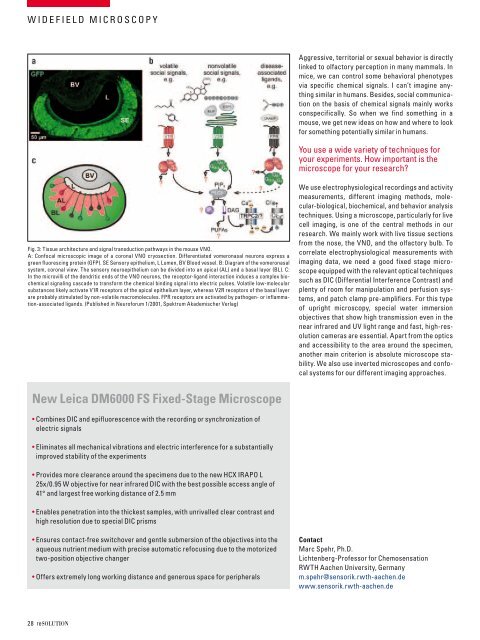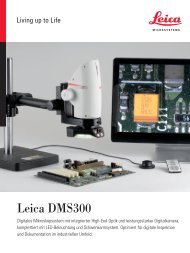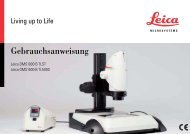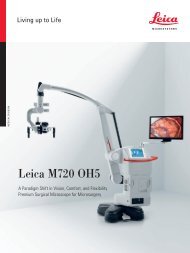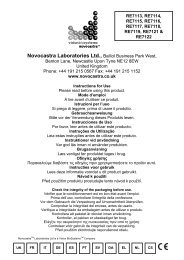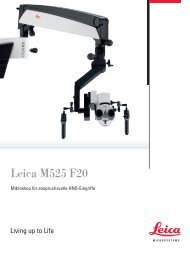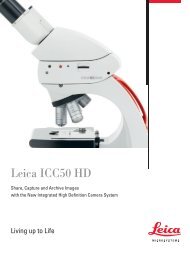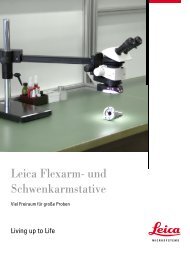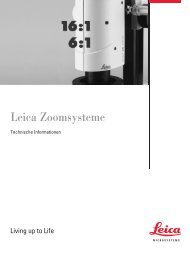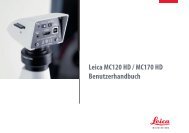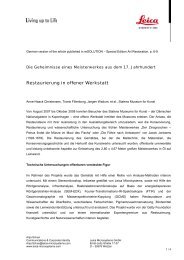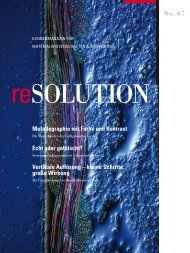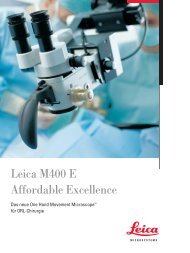reSOLUTION_Research_09_Neuroscience - Leica Microsystems
reSOLUTION_Research_09_Neuroscience - Leica Microsystems
reSOLUTION_Research_09_Neuroscience - Leica Microsystems
Create successful ePaper yourself
Turn your PDF publications into a flip-book with our unique Google optimized e-Paper software.
Widefield microscoPy<br />
fig. 3: tissue architecture and signal transduction pathways in the mouse Vno.<br />
a: confocal microscopic image of a coronal Vno cryosection. differentiated vomeronasal neurons express a<br />
green fluorescing protein (gfP). se sensory epithelium, l lumen, bV blood vessel. b: diagram of the vomeronasal<br />
system, coronal view. the sensory neuroepithelium can be divided into an apical (al) and a basal layer (bl). c:<br />
in the microvilli of the dendritic ends of the Vno neurons, the receptor-ligand interaction induces a complex biochemical<br />
signaling cascade to transform the chemical binding signal into electric pulses. Volatile low-molecular<br />
substances likely activate V1r receptors of the apical epithelium layer, whereas V2r receptors of the basal layer<br />
are probably stimulated by non-volatile macromolecules. fPr receptors are activated by pathogen- or inflammation-associated<br />
ligands. (Published in neuroforum 1/2001, spektrum akademischer Verlag)<br />
New <strong>Leica</strong> DM6000 FS Fixed-Stage Microscope<br />
• combines dic and epifluorescence with the recording or synchronization of<br />
electric signals<br />
• eliminates all mechanical vibrations and electric interference for a substantially<br />
improved stability of the experiments<br />
• Provides more clearance around the specimens due to the new HcX iraPo l<br />
25x/0.95 W objective for near infrared dic with the best possible access angle of<br />
41° and largest free working distance of 2.5 mm<br />
• enables penetration into the thickest samples, with unrivalled clear contrast and<br />
high resolution due to special dic prisms<br />
• ensures contact-free switchover and gentle submersion of the objectives into the<br />
aqueous nutrient medium with precise automatic refocusing due to the motorized<br />
two-position objective changer<br />
• offers extremely long working distance and generous space for peripherals<br />
28 resolutioN<br />
aggressive, territorial or sexual behavior is directly<br />
linked to olfactory perception in many mammals. in<br />
mice, we can control some behavioral phenotypes<br />
via specific chemical signals. i can’t imagine anything<br />
similar in humans. besides, social communication<br />
on the basis of chemical signals mainly works<br />
conspecifically. so when we find something in a<br />
mouse, we get new ideas on how and where to look<br />
for something potentially similar in humans.<br />
you use a wide variety of techniques for<br />
your experiments. How important is the<br />
microscope for your research?<br />
We use electrophysiological recordings and activity<br />
measurements, different imaging methods, molecular-biological,<br />
biochemical, and behavior analysis<br />
techniques. using a microscope, particularly for live<br />
cell imaging, is one of the central methods in our<br />
research. We mainly work with live tissue sections<br />
from the nose, the Vno, and the olfactory bulb. to<br />
correlate electrophysiological measurements with<br />
imaging data, we need a good fixed stage microscope<br />
equipped with the relevant optical techniques<br />
such as dic (differential interference contrast) and<br />
plenty of room for manipulation and perfusion systems,<br />
and patch clamp pre-amplifiers. for this type<br />
of upright microscopy, special water immersion<br />
objectives that show high transmission even in the<br />
near infrared and uV light range and fast, high-resolution<br />
cameras are essential. apart from the optics<br />
and accessibility to the area around the specimen,<br />
another main criterion is absolute microscope stability.<br />
We also use inverted microscopes and confocal<br />
systems for our different imaging approaches.<br />
Contact<br />
marc spehr, Ph.d.<br />
lichtenberg-Professor for chemosensation<br />
rWtH aachen university, germany<br />
m.spehr@sensorik.rwth-aachen.de<br />
www.sensorik.rwth-aachen.de


